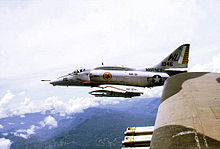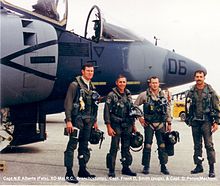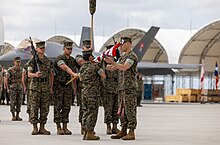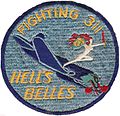VMFA-311
| Marine Fighter Attack Squadron 311 | |
|---|---|
 VMFA-311 insignia | |
| Active |
|
| Country | |
| Branch | |
| Type | Fighter/attack squadron |
| Role | Close air support Air interdiction Aerial reconnaissance |
| Nickname(s) | Tomcats Hells Belles (WWII) |
| Tail Code | WL |
| Engagements | |
| Commanders | |
| Notable commanders | Ralph K. Rottet Michael R. Yunck John P. Condon Paul J. Fontana John H. Miller Robert Sofge |
| Aircraft flown | |
| Fighter | |
Marine Fighter Attack Squadron 311(VMFA-311) is aUnited States Marine Corpsfighter attack squadron consisting ofF-35C Lightning II.Known as the "Tomcats", the squadron is based atMarine Corps Air Station Miramar,Californiaand falls under the command ofMarine Aircraft Group 11(MAG-11) and the3rd Marine Aircraft Wing(3rd MAW).
History
[edit]World War II
[edit]Commissioning & early training
[edit]Marine Fighting Squadron 311 (VMF-311) was commissioned on 1 December 1942 atMarine Corps Air Station Cherry Point,North Carolina.The squadron was assigned toMarine Aircraft Group 31of the3rd Marine Aircraft Wingand was commanded by MajorRalph K. Rottet.[2][3]The squadron moved toMarine Corps Air Station Parris Island,South Carolinaon 18 April 1943.[4]While at Parris Island, the squadron transitioned from flyingSNJ Texantrainersto flying the newly fieldedVought F4U Corsair.By the end of June, VMF-311 had 15 Corsairs on the flightline and had totally divested all of its SNJs.[5] On 31 August 1943, the squadron departed the east coast arriving atMarine Corps Air Depot Miramar,Californiaon 8 September 1943.[4]On 23 September 1943, VMF-311 along with the other MAG-31 squadrons embarked aboard theUSSNassau(CVE-16)headed for thePacific Theater.[6]
American Samoa & the Marshall Islands
[edit]VMF-311 participated in what was one of the earliest American catapult operations involving the Corsair when 21 F4Us launched fromUSSNassauon 6 October 1943 inbound toUnited States Naval Station Tutuila.[6]The squadron, along with the rest of MAG-31, was now part of the4th Marine Base Defense Aircraft Wing.On 8 October, VMF-311 aircraft flew to a newly constructedairfieldonWallis Islandwhere they remained until January 1944. During its time inAmerican Samoa,the squadron was responsible for flyingcombat air patrolsand other missions as required but did not engage any enemy aircraft.[6]
On 26 January 1944 VMF-311 personnel embarked on theUSSTyphoon(LST-1118)andUSSConstantinearriving atRoi-Namuron 6 February 1944.[4][7]Early in the morning on 12 February 1944, Japanese bombers hit Roi-Namur and destroying most of the squadron's equipment and all of its tents and personal gear. 14 officers and 99 enlisted Marines were casualties during this raid. On 24 February, the squadron was moved again, this time toKwajalein Atoll.Beginning on 23 March 1944, the squadron began flyingstrafingmissions againstWotje,Maloelap,Mille,Jaluit,andTaroa.[8]The strikes continued while the squadron moved back to Roi-Namur by 4 April. On 14 May, VMF-311 conducted its first bombing mission utilizing the F4U Corsair. During the squadron's time on Roi-Namur,Charles Lindbergh,at the time a consultant withUnited Aircraft,flew combat missions with the squadron.[9]VMF-311 continued in its roll of engaging bypassed Japanese Garrisons until March 1945.[8]
Okinawa and the end of the war
[edit]On 8 March 1945, the squadron embarked on theUSSSitkoh Bay(CVE-86)and theUSSBreton(CVE-23)with its newly arrived F4U-1Cs with 4 x 20mm cannons and four pairs of pylons forrockets.On 7 April, squadron aircraft landed atYontan Airfieldjoining theTactical Air Force, Tenth Armyduring theBattle of Okinawa.That same day the squadron scored its first enemy aircraft when multiple squadron aircraft flyingcombat air patrolengaged and destroyed akamikazeKawasaki Ki-48headed for theSitkoh Bay.[10]During the month of April the squadron was credited with shooting down 22 enemy aircraft and in May another 37.[11]
On 1 July the squadron departed Yontan to begin operations fromChimu Airfield,also on Okinawa. The next day, four squadron aircraft took part in the unit's first fighter sweeps againstKyushu.[12]Two more were conducted during the rest of July. At the close of combat operations on Okinawa, VMF-311 was credited with shooting down 71[13][14]Japanese aircraft in a four-month period.[15]This was the second highest total of Japanese aircraft in the Tactical Air Force.[12]During its five months on Okinawa, the squadron lost 16 aircraft with 3 pilots killed.[16]On 9 September 1945, the squadron departed Chimu Airfield forYokosuka Naval Airfield.[17]
1946–1950
[edit]
On 17 September 1945, the squadron landed at theYokosuka Naval Districtto begin occupation duty in mainlandJapan.[15]Occupational duty in Japan lasted till May 1946, when MAG-31 was notified to prepare for the termination of its Japanese assignment; VMF-311 was going home.[18]Between July 1946 and April 1947 the squadron had a sleeping existence and being transferred to MAG-32 and later MAG-12 while consisting of one officer, but in 1949 VMF-311 became the first West Coast Marine jet squadron when it started flying theTO-1 Shooting Star.Coincidentally the squadron was re-designated Marine Fighter Squadron 311 (VMF-311) and around that time acquired the code lettersWL,phonetically pronounced as "William Love," but from which also came the nickname "Willy Lovers".[19]The squadron quickly transitioned to theF9F Pantherin October 1949 and found itself once again preparing for war by November 1950, arriving once again at Yokusuka airfield in Japan.
The Korean War, 1950–1955
[edit]
Arriving inSouth Koreaon 7 December 1950, VMF-311 was the first land-based Marine jet squadron to be used in combat providingclose air supportfor the Marines and Soldiers on the ground.[20]In late-June 1952 the squadron participate in theattack on the Sui-ho Dam.Additionally, the squadron pioneered strip-alert tactics still practiced today. Legendary pilots during this era included later astronaut and SenatorJohn Glennand baseball starTed Williams.In over2+1⁄2years of action in Korea the squadron amassed 18,851 combat sorties. In 1957, the squadron finally was re-designated Marine Attack Squadron 311 (VMA-311). The nickname "Tomcats" was also bestowed during this era.
Vietnam War
[edit]
The firstA4D-2 Skyhawkwas received in the summer of 1958, initiating 30 years of Skyhawk service. In May 1965 the squadron, now flying A-4Es, deployed toChu Lai Air Base,South Vietnamand on 2 June, they conducted their first combat mission of the Vietnam War. In August 1965, VMA-311 supported the7th Marine RegimentinOperation Starlite,the first major American operation of the war.[21]The squadron recorded a four-day sortie total of 240 from 5 to 8 May 1968 in support of their fellow marines during theBattle of Khe Sanh.[22]
The squadron moved toDanang Air Basein late July 1970.[23]In early 1971 the squadron provided support forOperation Lam Son 719the South Vietnamese offensive intoLaosand was credited with destroying eightPeople's Army of Vietnamtanks.[24]During May 1971 the squadron readied for redeployment, flying their last mission on 7 May before leaving South Vietnam on 12 May.[24]
The squadron rejoinedMarine Aircraft Group 12(MAG-12) atMCAS Iwakuniwith the entire squadron redeployed by 27 May 1971.[24]On 29 October the squadron deployed toNaha Air Baseuntil 15 January 1972.[25]
On 16 May 1972 VMA-311 once again deployed to South Vietnam with MAG-12 Forward andVMA-211toBien Hoa Air Basein response to the North VietnameseEaster Offensive.[26]The squadron would supportArmy of the Republic of Vietnamforces fighting in theBattle of An Loc.[25]Their final sortie in-country would occur on 29 January 1973, a day before they would drop the last ordnance from a Marine A-4 Skyhawk during the war. VMA-311 would fly 54,625 combat sorties during their time supporting operations in Vietnam, Laos and Cambodia.[27]
The Gulf War
[edit]
In 1988 VMA-311 received its firstAV-8B Harrierand shortly thereafter headed into harm's way again. On 11 August 1990, after theIraqiinvasion ofKuwait,VMA-311 deployed in support ofOperation Desert Shield,leading all other Marine fixed-wing squadrons intoSaudi Arabiawhere they were based out ofKing Abdulaziz Naval Base.While there, the Tomcats were the most forward deployed fixed-wing squadron. On 17 January 1991 while in support ofOperation Desert Stormthe squadron became the first to utilize the AV-8B in combat when a flight of four Harriers destroyed an Iraqiartilleryposition in support of the Battle of Khafji. During 43 days of air combat operations, Tomcat pilots flew 1,017 combat missions and delivered 840 tons of ordnance against enemy targets throughout Kuwait and Southern Iraq.

Global War on Terrorism
[edit]On 3 November 2001, VMA-311 Harriers attached to the15th Marine Expeditionary Unitembarked aboardUSSPeleliubecame the first Harriers to fly combat missions inAfghanistanduringOperation Enduring Freedom.
On 15 January 2003, VMA-311 deployed to the NorthernPersian Gulfas part of Amphibious Task Force West. On 21 March 2003, almost 59 years to the day after VMF-311’s first combat sortie inWorld War II,they flew their first combat sortie ofOperation Iraqi Freedom.During the war they flew over 550 sorties while dropping 77 tons of precision ordnance, destroying or neutralizing 132 Iraqi targets while operating from two amphibious assault carriers,USSBonhomme RichardandUSSTarawa.The squadron returned from the Persian Gulf on 24 July 2003. In October 2004, the squadron deployed to Al Asad Air Base in Iraq in support of Operation Iraqi Freedom, while simultaneously deploying a 6 jet 90 Marine detachment to MAG-12 in Iwakuni, Japan to support the 31st Marine Expeditionary Unit. In September of 2006, a contingent of 6 jets was sent to support the 15th MUE aboard the USS Boxer (LHD 4), which was subsequently sent into Al Asad, Iraq to support their sister squadron VMA-211. The detachment left Iraq to return to the USS Boxer in April of 2007 to return to their home base of Yuma, AZ. In early 2008, the squadron made its final deployment to Al Asad Air Base in support of Operation Iraqi Freedom, while simultaneously deploying a 6 jet detachment aboard the USS Peleliu (LHA 5) in support of the 15th Marine Expeditionary Unit. The squadron's 2008 deployment to Iraq marked the Marine Corps Harrier's final participation in Operation Iraqi Freedom, and on 5 October 2008, VMA-311's aircraft were the last Harriers to fly combat missions in support of Operation Iraqi Freedom. For the year 2008, VMA-311 had the distinction of being selected as the Marine Corps "Attack Squadron of the Year" by the Marine Corps Aviation Association (MCAA). Operation Iraqi Freedom deployments were soon followed in 2010 with deployments again to the 15th MEU and a Unit Deployment Program to the Pacific region. While there, they spent over two months aboardUSSEssexwith the 31st MEU while participating in the multilateral exercises Cobra Gold 2010 andBalikatan2010. VMA-311 deployed toCamp Bastion,Helmand Province,Afghanistanin support of Operation Enduring Freedom from April to September 2013.
Decommissioning (2020)
[edit]VMA-311 was decommissioned at MCAS Yuma on 15 October 2020.[1]
Reactivation (2023)
[edit]
The squadron was reactivated on 14 April 2023 and will work in tandem withVMFA-314to transition toF-35Cs.The transition is due to be concluded by 2024.[28]
Squadron aces
[edit]The following Marines from VMA-311 have been credited asFlying aces:[29][30]
- 2nd Lt.William P. Brown Jr.- 7.0
- Maj.Michael R. Yunck- 7.0 (5.0 with VMA-311)[31]
- Maj. Perry L. Shuman - 6.0
Notable former members
[edit]- Eugene R. Brady- recipient of theNavy Crossfor action during theVietnam Warflew with VMF-311 during the Korean War.
- Ted Williams- Hall of Fame baseball player flew with the squadron during the Korean War.
- John H Glenn Jr.- engineer, astronaut, businessman, and politician. He was the third American in space, and the first American to orbit the Earth, circling it three times in 1962, also flew with the squadron during the Korean War.[32]
Gallery
[edit]-
VMF-311 insignia during World War II
-
VMF-311 Logo during the Korean War
See also
[edit]- United States Marine Corps Aviation
- List of United States Marine Corps aircraft squadrons
- List of decommissioned United States Marine Corps aircraft squadrons
Citations
[edit] This article incorporatespublic domain materialfrom websites or documents of theUnited States Marine Corps.
This article incorporatespublic domain materialfrom websites or documents of theUnited States Marine Corps.
- ^abBarison, Gabriele (21 October 2020)."VMA-311 Deactivated as USMC Retires Iconic Harrier Jump Jet. Tomcats Will Reactivate as VMFA-311 Operating The F-35C Lightning II".theaviationgeekclub.Retrieved25 October2020.
- ^Sambito 1978,pp. 1.
- ^3d MAW General Order 2-1942 Commissioning VMF-311 on 1 December 1942
- ^abcSherrod 1952,pp. 467.
- ^Sambito 1978,pp. 2–3.
- ^abcSambito 1978,pp. 3.
- ^Sambito 1978,pp. 4.
- ^abSambito 1978,pp. 5.
- ^Mersky 1983,pp. 93.
- ^Sambito 1978,pp. 7.
- ^Sambito 1978,pp. 8.
- ^abSambito 1978,pp. 9.
- ^Tillman 1979,pp. 152.
- ^Styling 1995,pp. 80.
- ^ab"Wings Over Fujiyama".The Pendleton Scout.Marine Corps Base Camp Pendleton. 11 February 1946. p. 2.Retrieved22 December2021.
- ^Tillman 2014,pp. 123.
- ^Sambito 1978,pp. 10.
- ^Sambito 1978,pp. 11.
- ^Sambito 1978,pp. 14.
- ^http://collections.naval.aviation.museum/emuwebdoncoms/pages/doncoms/Display.php?irn=16001491&QueryPage=%2FDtlQuery.phpArchived2008-12-22 at theWayback MachineNational Museum of Naval Aviation
- ^Sambito 1978,pp. 41.
- ^Dorr 2005,pp. 205.
- ^Sambito 1978,pp. 51.
- ^abcSambito 1978,pp. 52.
- ^abSambito 1978,pp. 53.
- ^"USMC Status of Forces January - June 1973"(PDF).usmcu.edu.United States Marine Corps. p. 172.Retrieved24 May2022.
- ^Mersky 1983,pp. 281.
- ^"2018 Marine Aviation Plan"(PDF).Marines.mil.2018.
- ^List of WW2 Marine Aces,acepilots, 21 December 2007
- ^Sambito 1978,pp. 9–10.
- ^Styling 1995,pp. 87–90.
- ^Sambito, William.A History of Marine Attack Squadron 311 PCN 19000308000(PDF).p. 25.Retrieved18 January2023.
References
[edit]- Bibliography
- Dorr, Robert F. (2005).Marine Air - The History of the Flying Leathernecks in Words and Photos.Penguin Books.ISBN0-425-20725-0.
- Mersky, Peter (1983).U.S. Marine Corps Aviation 1912 to the Present.Annapolis, MD: Nautical & Aviation Publishing Company of America.
- Sambito, William J. (1978).History of Marine Attack Squadron 311(PDF).Washington D.C.: History and Museums Division, Headquarters Marine Corps.
- Sherrod, Robert (1952).History of Marine Corps Aviation in World War II.Washington, D.C.: Combat Forces Press.
- Styling, Mark (1995).Corsair Aces of World War 2.Botley, Oxford, UK: Osprey Publishing.ISBN1-85532-530-6.
- Tillman, Barrett (1979).Corsair - The F4U in World War II and Korea.Annapolis, MD: Naval Institute Press.ISBN1-55750-994-8.
- Tillman, Barrett (2014).US Marine Corps Fighter Squadrons of World War II.Osprey Publishing.ISBN978-1782004103.




